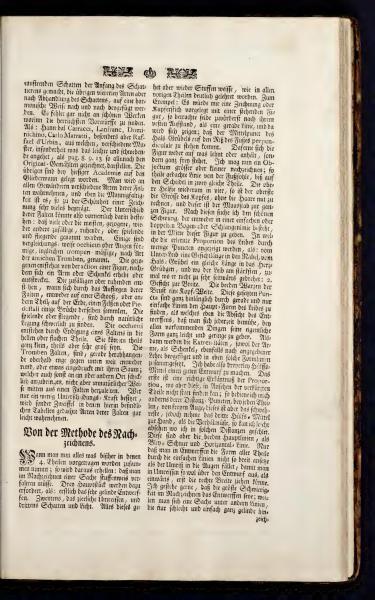On the Method of Tracing.
Taking into account everything previously explained in the 4 Sections, it becomes clear that tracing requires precise execution. Clean work is necessary, first ensuring that the outlines are very precise. Certain softer lines may blend and project shadows. All of this pertains to different stages, as clearly laid out in previous sections. For example, if a work is presented to me from an engraving with a living figure, I should reconsider its original state as a straight line. It will then show that the midpoint of the wooden frame coincides perpendicularly with the incision at the center of the wood. Meanwhile, the figures can stand independently, without any support. An observation can be made, marking the great line from the foot up to the top of the head or into a straight angle. The upper section again divides into four; the top part represents the size of the head, excluding the hair, and this is the standard measure for the entire figure. According to this, I derive the beautiful outline, whether in a simple or double oval or an oblique mark, giving a similar figure in perspective. I pay attention to maintaining its proportion through some lines, as from below: the face in children, and then how some parts can be painted to be of equal length; 2. Highlight the central points at the front of the breast and hip-bone. These points make it easier to find a simple and overall symmetric form of the body's front; therefore I notice that in existing objects the difference needs to be both subtle and obvious.
Thus, I have variously used these means as a convenient approach. The first is a correct declaration of proportions, where, however, in the rise of the limb is not undertaken, I adjust myself to certain failing shapes, repeating notes at length; everyone considers this as a fourth use. A word or a contour, especially when the distance is held, fails in such cases. These but for the perspective must give only three: as walls, corner, and horizontal line. Only then within the work's outline should the form be further developed, avoiding exaggeration in the dimensions to restrain the work and keep it within a good plan. This completes a task under one pillar; surpassing it when doing quickly.
Translation Notes:
- "Kupferstich" refers to an engraving or etched print made with copper.
- "Hults Cutricle" appears metaphorical and may refer to an imagined framework.
The text explains the precise execution required for tracing, emphasizing the importance of clean work and accurate outlines. It contrasts different stages and gives an example involving engraving, with attention to maintaining proportion. It further details methods for ensuring correct proportions and how overemphasis on certain parts should be avoided, incorporating translation notes to clarify historic references.
